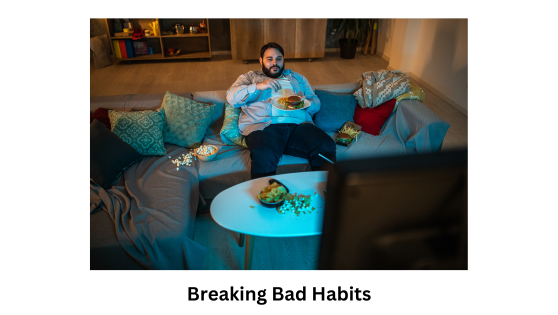Breaking Bad Habits
Breaking bad habits is one of the most challenging yet rewarding pursuits for personal growth. These habits can often feel ingrained and difficult to shake, but with a thoughtful approach, it’s entirely possible to replace them with healthier behaviors. This article delves into the complexities of breaking bad habits, exploring various perspectives and strategies to help you overcome these persistent behaviors.

Understanding the Nature of Bad Habits
1. Neurological Basis: Bad habits are often formed and reinforced through neural pathways in the brain. The more frequently a behavior is repeated, the stronger the neural connections become, making the habit more automatic and harder to break.
2. Psychological Factors: Emotional and psychological triggers, such as stress, boredom, or anxiety, often underlie bad habits. Understanding the psychological reasons behind your habits can help you address the root causes and find healthier alternatives.
3. Environmental Influences: Your surroundings and social environment play a significant role in habit formation. Identifying environmental triggers and modifying your environment can be crucial steps in breaking bad habits.
Strategies for Breaking Bad Habits
1. Identify Triggers and Patterns: The first step in breaking a bad habit is to identify the triggers and patterns associated with it. Keep a habit journal to track when and where the habit occurs, how you feel at the time, and what precedes the behavior. This awareness is essential for developing strategies to disrupt the habit loop.
2. Replace with Positive Habits: Rather than simply trying to eliminate a bad habit, focus on replacing it with a positive one. This approach leverages the existing habit loop by substituting a healthier behavior for the unwanted one. For example, if you tend to snack when stressed, try replacing snacking with a quick walk or deep breathing exercises.
3. Use the Inversion of the Four Laws of Behavior Change: James Clear’s four laws of behavior change can be inverted to help break bad habits:
– Make It Invisible: Reduce exposure to the triggers of your bad habit. For instance, if you want to stop eating junk food, don’t keep it in the house.
Make It Unattractive: Reframe your mindset to see the negative aspects of the habit. Educate yourself on the adverse effects of the behavior to make it less appealing.
– Make It Difficult: Increase the effort required to engage in the habit. For example, if you want to spend less time on social media, log out of your accounts after each use.
– Make It Unsatisfying: Attach immediate consequences to the habit. Use a habit contract or accountability partner to impose a penalty for engaging in the behavior.
4. Implement Gradual Changes: Drastic changes can be overwhelming and unsustainable. Instead, focus on gradual modifications to your behavior. Small, incremental changes are easier to manage and can lead to long-term success.
Psychological Approaches to Breaking Bad Habits
1. Mindfulness and Self-Awareness: Practicing mindfulness can help you become more aware of your habits and the triggers that lead to them. Mindfulness techniques, such as meditation and deep breathing, can reduce stress and increase your ability to respond thoughtfully rather than react impulsively.
2. Cognitive Behavioral Therapy (CBT): CBT is a therapeutic approach that helps individuals identify and change negative thought patterns and behaviors. Working with a therapist or using CBT techniques can provide structured support for breaking bad habits.
3. Motivational Interviewing: This counseling approach helps individuals resolve ambivalence and find the motivation to change. It involves exploring the pros and cons of the habit, setting goals, and building confidence in your ability to change.
Social and Environmental Support
1. Accountability Partners: Sharing your goals with a trusted friend or family member can provide support and accountability. An accountability partner can offer encouragement, monitor your progress, and help you stay committed to breaking the habit.
2. Support Groups: Joining a support group with individuals facing similar challenges can provide a sense of community and shared purpose. Support groups offer a space to share experiences, learn from others, and receive encouragement.
3. Environmental Design: Modify your environment to reduce triggers and make it easier to avoid the habit. This could involve changing your physical space, such as rearranging your home, or creating new routines that support your goals.
Overcoming Setbacks
1. Anticipate Challenges: Recognize that setbacks are a natural part of the process. Anticipating challenges and planning for them can help you stay resilient. Identify potential obstacles and develop strategies to overcome them.
2. Practice Self-Compassion: Be kind to yourself when you experience setbacks. Rather than viewing them as failures, see them as opportunities to learn and grow. Self-compassion can help you maintain a positive mindset and stay committed to your goals.
3. Reflect and Adjust: Regularly reflect on your progress and adjust your strategies as needed. What worked and what didn’t? Use these insights to refine your approach and continue moving forward.
Conclusion
Breaking bad habits is a complex and multifaceted process that requires understanding, patience, and persistence. By identifying triggers, replacing negative behaviors with positive ones, leveraging psychological approaches, and seeking social and environmental support, you can overcome even the most ingrained habits. Remember, the journey to breaking bad habits is not linear, and setbacks are part of the process. Embrace the challenge, stay committed, and celebrate your progress along the way. With dedication and the right strategies, you can transform your habits and achieve lasting positive change.